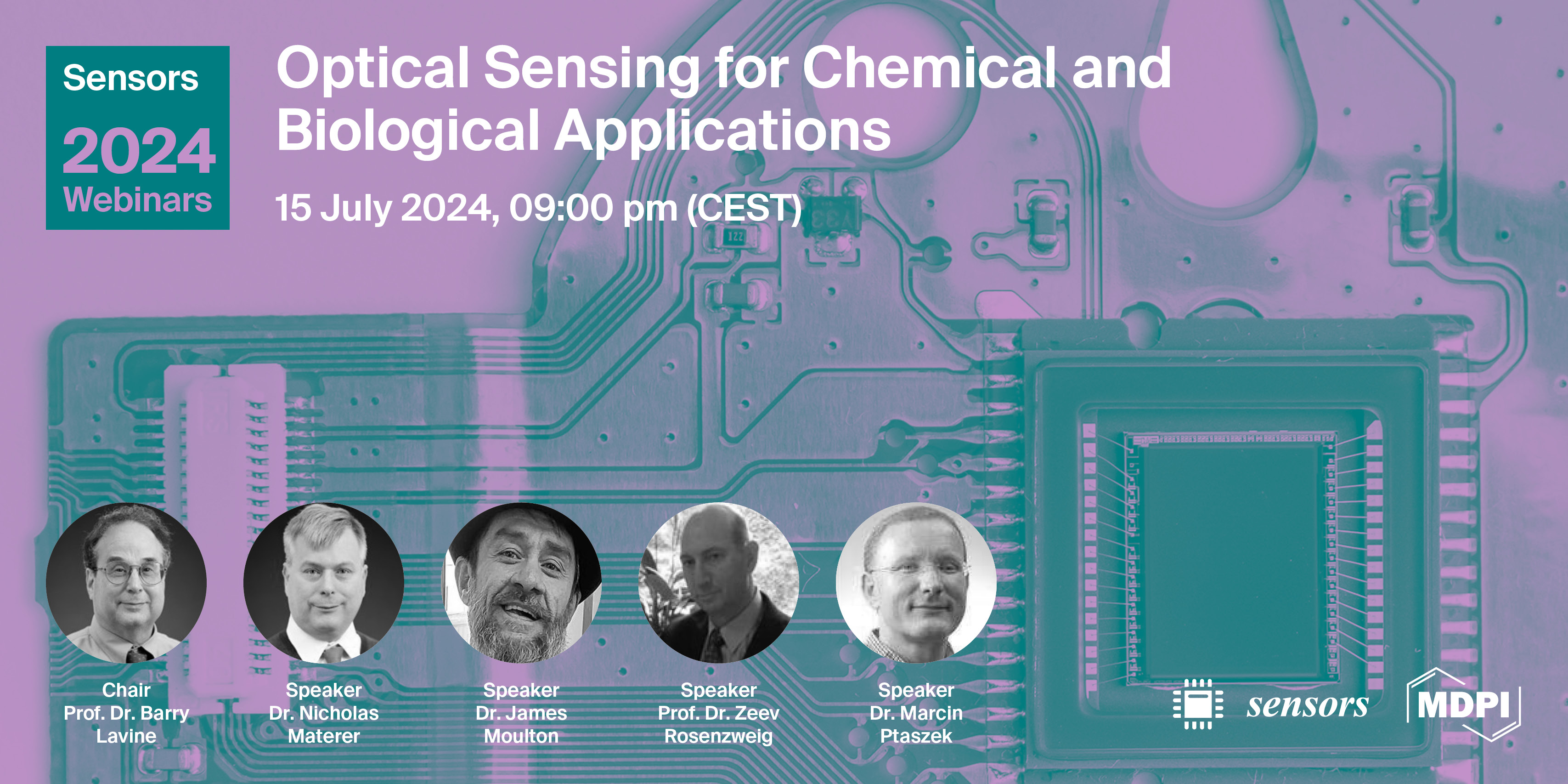
Sensors Webinar | Optical Sensing for Chemical and Biological Applications, 15 July 2024
The webinar Chair’s introduction:
It is my honor to serve as the Chair of this session devoted to optical sensing. Chemical sensors based on optical sensing play an ever-growing role in the detection and identification of historical, transient, or emerging events that are industrial, environmental, or biological in origin. These events play key roles in understanding the impact and prognosis of crucial processes in a variety of settings. For this session, three papers from the Special Issue have been selected to highlight industrial, environmental, and biological sensing application areas.
Our first speaker is Nicholas Materer, who investigates the detection of hydrogen peroxide in solutions encountered in industrial settings via a colorimetric method using test strips composed of a titanium (IV) compound with Ti-O-Ti-O-zig-zag chains coordinated to water and hydrogen sulfate ions. The second speaker is James Moulton, who will speak about measuring the turbidity of swellable copolymers of N-isopropylacrylamide (NIPA) to determine pH in ocean and seawater. The response of the NIPA copolymers to pH as a function of ionic strength and temperature of the solution in contact with the polyvinyl alcohol hydrogel membrane containing the NIPA copolymer particles was investigated. Variations in the polymer formulation, including the pH functional comonomer, crosslinker, and lower critical solution temperature modulator, were also investigated to understand their effect on the pH response of the polymer particles. The third speaker, Zeev Rosenzweig, will focus on recent advances in fluorescence bioimaging and sensing with nanoscale luminescent polymer dots (Pdots)—specifically, the use of organic dyes as dopant molecules to modify their optical properties to enable deep-red and near-infrared fluorescence bioimaging applications, as well as to impart the sensitivity of dye-doped Pdots towards selected analytes such as FLAG-tagged FLS2 membrane receptors in genetically engineered plant leaf cells. The fourth speaker is Marcin Ptaszek, who will give a presentation on hydroporphyrin energy-transfer arrays for bioimaging. The wide range of sensing technologies covered in this webinar, including novel analytical methodologies, unique platforms, and improvements in existing methods, are expected to be impactful for the future.
Date: 15 July 2024
Time: 9:00 p.m. CEST | 3:00 p.m. ET | 3:00 a.m. CST Asia
Webinar ID: 862 6295 5568
Webinar Secretariat: journal.webinar@mdpi.com
Webinar Announcement: https://sciforum.net/event/Sensors-19
Register now for free!
|
Speaker/Presentation |
Time in CEST |
Time in EDT |
|
Prof. Dr. Barry K. Lavine |
9:00 p.m.–9:10 p.m. |
3:00 p.m.–3:10 p.m. |
|
Dr. Nicholas Materer |
9:10 p.m.–9:30 p.m. |
3:10 p.m.–3:30 p.m. |
|
Dr. James T. Moulton |
9:30 p.m.–9:50 p.m. |
3:30 p.m.–3:50 p.m. |
|
Dr. Marcin Ptaszek |
9:50 p.m.–10:10 p.m. |
3:50 p.m.–4:10 p.m. |
|
Prof. Dr. Zeev Rosenzweig |
10:10 p.m.–10:30 p.m. |
4:10 p.m.–4:30 p.m. |
|
Q&A Session |
10:30 p.m.–10:45 p.m. |
4:30 p.m.–4:45 p.m. |
|
Prof. Dr. Barry K. Lavine |
10:45 p.m.–10:50 p.m. |
4:45 p.m.–4:50 p.m. |
After registering, you will receive a confirmation email containing information on how to join the webinar. Registrations with academic or institutional email addresses will be prioritized.
Unable to attend? Feel free to still register, and we will inform you when the recording is available.
Webinar Chair and Keynote Speakers:
- Prof. Dr. Barry Lavine, Oklahoma State University, USA;
- Dr. Nicholas Materer, Oklahoma State University, USA;
- Dr. James Moulton, Oklahoma State University, USA;
- Prof. Dr. Zeev Rosenzweig, Oklahoma State University, USA;
- Dr. Marcin Ptaszek, Oklahoma State University, USA.
Relevant Special Issue:
“Optical Sensing for Chemical and Biological Applications”
Guest Editors: Prof. Dr. Barry K. Lavine and Prof. Dr. Karl Booksh
Deadline for manuscript submissions: 31 July 2024